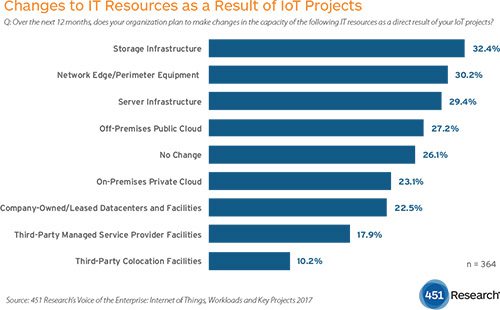There’s little argument that the explosive growth of the Internet of Things (IoT) market is having a major impact on the IT industry. For most enterprises, some of that impact will be felt on their IT budgets, suggests a new study from 451 Research.
Nearly two-thirds (65.6 percent) of the 575 IT and IoT decision-makers polled by analyst firm said they expect to increase their IT spending in the next 12 months because of planned IoT deployments. A scant 2.7 percent expect to reduce their spending instead.
Data storage infrastructure (32.4 percent) is the leading beneficiary of that all that new IoT-related spending as businesses seek to increase capacity, followed closely by network edge equipment (30.2 percent) and server infrastructure (29.4 percent). IoT projects are also driving investments in public cloud services (27.2 percent) and on-premises private cloud solutions (23.1 percent).
More than a quarter (26.1 percent) of respondents said they expected no change in terms of their IT resources.
451 Research found that despite a tendency to centralize IoT data — a majority of organizations analyze (59.1 percent) and initially store (53.1 percent) IoT data in a company-owned data center — the network edge is emerging as a hotspot for IoT workloads.
“Companies are processing IoT workloads at the edge today to improve security, process real-time operational action triggers, and reduce IoT data storage and transport requirements,” said Rich Karpinski, research director at 451 Research. “While some enterprises say that in the future they will do more analytics – including heavy data processing and analysis driven by big data or AI – at the network edge, for now that deeper analysis is happening in company-owned datacenters or in the public cloud.”
Nearly half of the organizations polled for the survey said they process IoT data, which include data aggregation, filtering or analysis, on the edge. Just over 22 percent of respondents said they perform these tasks on either the IoT device itself and 23.3 percent rely on nearby IT infrastructure.
For now, enterprises are generally embarking on IoT projects that tackle in data center management, security monitoring and surveillance. In two years, 451 Research expects facilities automation to take the crown while IoT-enabled line-of-business processes like supply chain management gain in popularity.
Mirroring the general IT talent crunch that is affecting many businesses today, finding IoT experts is a challenge. Nearly half of all respondents reported a IoT skills shortage, particularly pertaining to data analytics, virtualization and security.
Pedro Hernandez is a contributing editor at Datamation. Follow him on Twitter @ecoINSITE.



